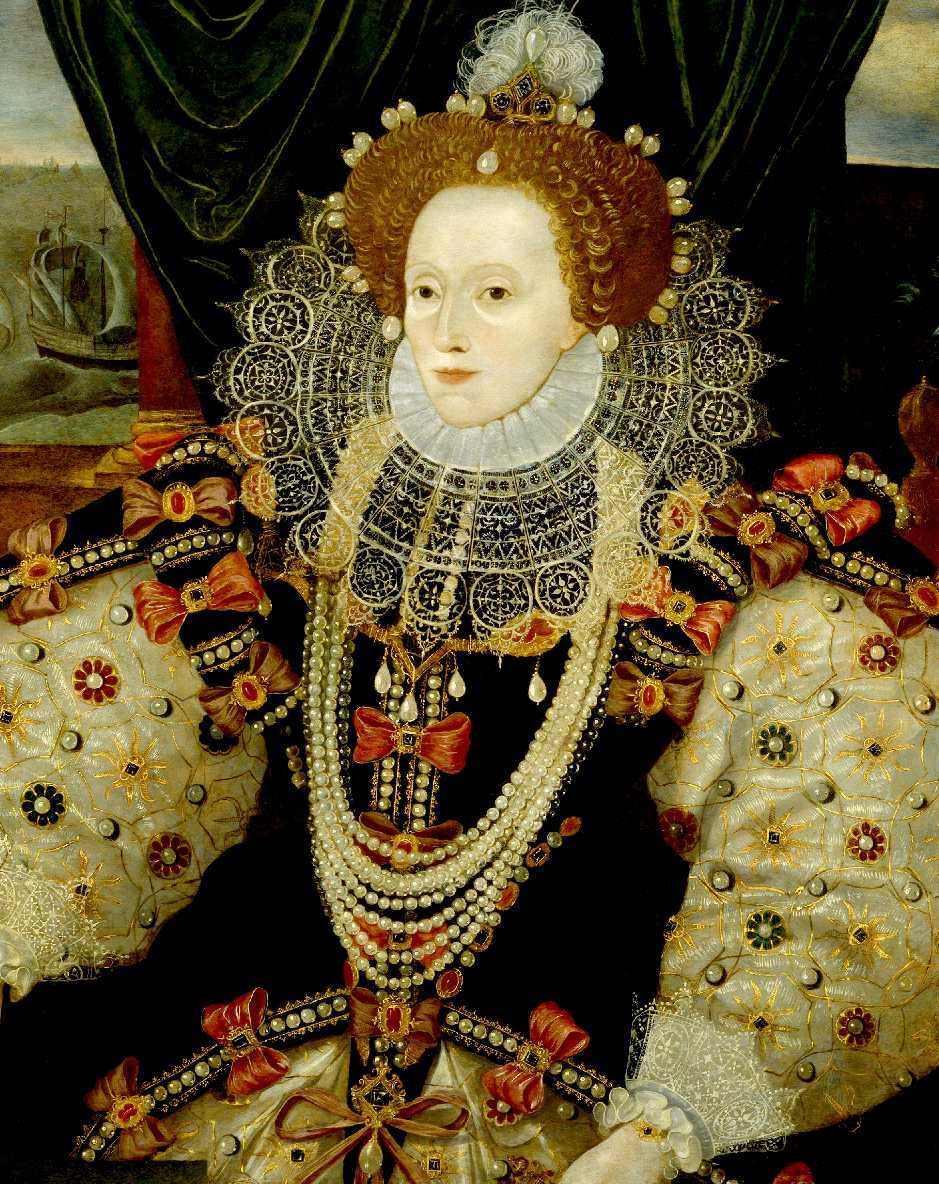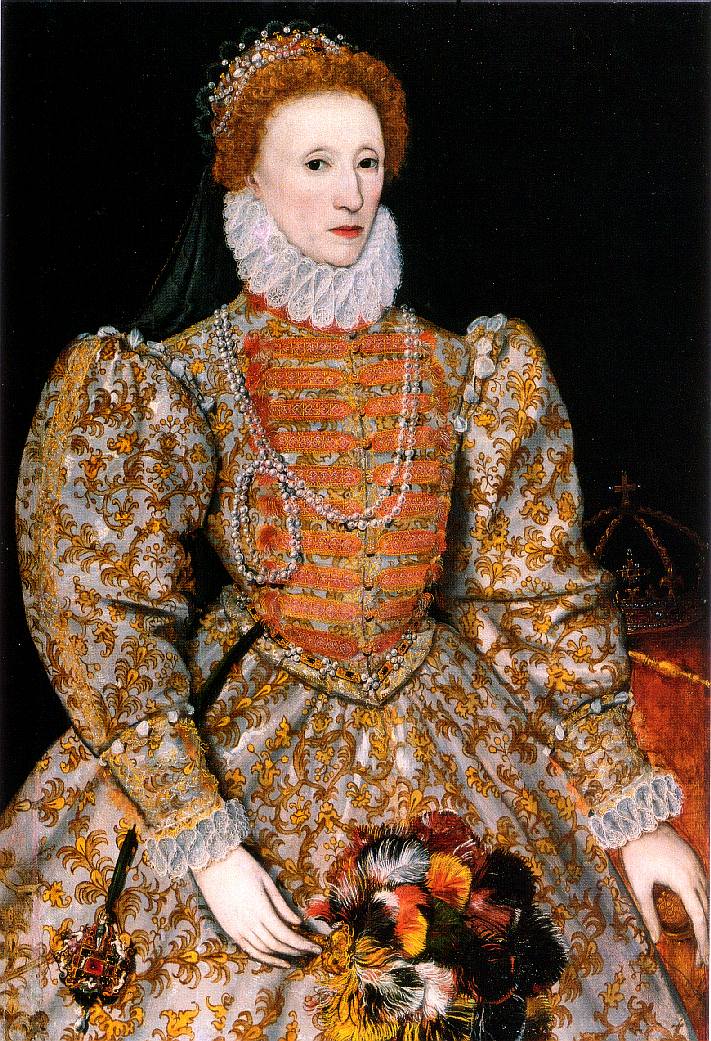
Queen Elizabeth
I - Good Queen Bess
Elizabeth I
(born 7 September 1533) was Queen of England and Ireland from 17 November 1558 until her death on 24 March 1603. Sometimes called The Virgin Queen, Gloriana or Good Queen Bess, Elizabeth was the last monarch of the House of Tudor.
Elizabeth was the daughter of Henry VIII and Anne Boleyn, his second wife, who was executed two-and-a-half years after Elizabeth's birth. Anne's marriage to Henry VIII was annulled, and Elizabeth was declared illegitimate. Her half-brother, Edward VI, ruled until his death in 1553, bequeathing the crown to Lady Jane Grey and ignoring the claims of his two half-sisters, Elizabeth and the Roman Catholic Mary, in spite of statute law to the contrary. Edward's will was set aside and Mary became queen, deposing Lady Jane Grey. During Mary's reign, Elizabeth was imprisoned for nearly a year on suspicion of supporting Protestant rebels.
In 1558, Elizabeth succeeded her half-sister to the throne and set out to rule by good counsel. She depended heavily on a group of trusted advisers, led by William Cecil, 1st Baron Burghley. One of her first actions as queen was the establishment of an English Protestant church, of which she became the Supreme Governor. This Elizabethan Religious Settlement was to evolve into the Church of England. It was expected that Elizabeth would marry and produce an heir to continue the Tudor line. She never did, despite numerous courtships. As she grew older, Elizabeth became famous for her virginity. A cult grew around her which was celebrated in the portraits, pageants, and literature of the day.
In government, Elizabeth was more moderate than her father and half-siblings had been. One of her mottoes was "video et taceo" ("I see but say nothing"). In religion, she was relatively tolerant and avoided systematic persecution. After the pope declared her illegitimate in 1570 and released her subjects from obedience to her, several conspiracies threatened her life, all of which were defeated with the help of her ministers' secret service.
Elizabeth was cautious in foreign affairs, manoeuvring between the major powers of France and Spain. She only half-heartedly supported a number of ineffective, poorly resourced military campaigns in the Netherlands, France, and Ireland. By the mid-1580s, England could no longer avoid war with Spain. England's defeat of the Spanish Armada in 1588 associated Elizabeth with one of the greatest military victories in English history.
Elizabeth's reign is known as the Elizabethan era. The period is famous for the flourishing of English drama, led by playwrights such as William Shakespeare and Christopher Marlowe, and for the seafaring prowess of English adventurers such as
Francis
Drake. Some historians depict Elizabeth as a short-tempered, sometimes indecisive ruler, who enjoyed more than her share of luck. Towards the end of her reign, a series of economic and military problems weakened her popularity.
Elizabeth is acknowledged as a charismatic performer and a dogged survivor in an era when government was ramshackle and limited, and when monarchs in neighbouring countries faced internal problems that jeopardised their thrones. Such was the case with Elizabeth's rival, Mary, Queen of Scots, whom she imprisoned in 1568 and had executed in 1587. After the short reigns of Elizabeth's half-siblings, her 44 years on the throne provided welcome stability for the kingdom and helped forge a sense of national identity.

THE
SEA DOGS
The sea dogs, as they were disparagingly called by the Spanish authorities, were
privateers who, with the consent (and sometimes financial support) of Elizabeth I of England (r. 1558-1603 CE), attacked and plundered Spanish colonial settlements and treasure ships in the second half of the 16th century CE. With only a license from their queen to distinguish them from pirates, mariners like
Sir Francis Drake (c. 1540-1596 CE) and
Sir Walter Raleigh (c. 1552-1618 CE) made themselves and their backers immensely rich. Elizabeth and her government, unable to trade legitimately with the colonies of the New World as Philip II of Spain (r. 1556-1598 CE) held on to his monopoly, turned instead to robbery as a means to persuade the Spanish king to change policy.
As Anglo-Spanish relations deteriorated, the privateers became a useful tool in reducing the wealth of Spain and disrupting Philip’s plans to build his Armada fleet with which he hoped to invade England. Although in some respects successful, especially with such captures as the great treasure ship the Madre de Deus, the
privateers did not work together sufficiently to pose a serious and sustained threat to Spanish shipping, which began to use armed convoys to great effect. For a few decades, though, the fast English ships bristling with cannons and captained by audacious adventurers, caused havoc on the High Seas.
Please use our
A-Z INDEX to
navigate this site

